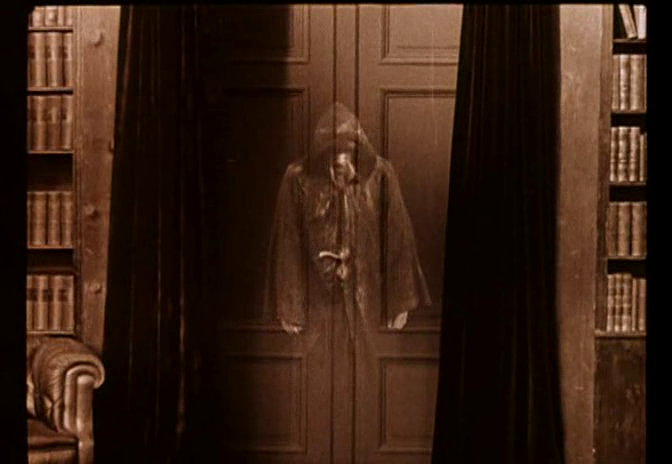A Century of Film is an ongoing series, looking at one film released each year from 1917 to present. The film representing 1921 is The Phantom Carriage.
Film is international, so while our first four films in this ongoing series came from America, I believe now it is a good time to switch it up and view something from another country. For our first foreign film in the series, I have decided to go with a film from Sweden, and to take a ride in The Phantom Carriage.
The film starts with a sister of the Salvation Army known as Edit (Astrid Holm) who is having a bad day mostly because she’s dying. She wants a man named David Holm (Victor Sjöström, who also wrote and directed) at her deathbed, getting her friends to go fetch him. When we meet Holm, we don’t really know why she wants this guy to visit her, since he’s a drunken lout telling ghost stories in a graveyard with some other drunken louts. He tells the tale of a man named Gregor (Tor Svennberg), who was paranoid about dying on New Years’ Eve, because the last person to die every year has to drive death’s carriage for a year, picking up all the souls of the departed. In spite of this paranoia, he happened to die at the stroke of midnight on New Years’ Eve anyway, which happened to be exactly a year ago. Also, since Holm is an idiot, he gets into a fight, gets a blow to the head, and suddenly Gregor has arrived in a big transparent carriage to make him repent and also take over death wagon duties.
The film is mostly concerned with the wrecking ball of a life that Holm leads, though it leans a bit too hard on making him an awful person - while he does have a few scenes in an idyllic field before he falls hard into a life of sin and alcohol, it can be a struggle to understand why anyone actually likes him. His actions are largely irredeemable, even as Edit remains convinced that he can repent and be a good person again. He rewards Edit mostly by yelling at her and ripping up her hard work. It takes a good actor to make a terrible person seem okay, and Sjöström is up to the task, he makes Holm into someone sympathetic even though we know he’s terrible to his wife (Hilda Borgström) and to people like Edit who love him for some obscure reason. Sjöström lobbied hard for the chance to bring the film to the screen, and he puts in a tour de force performance as Holm, bringing a vulnerability to a character who spends most of his time being a loud buffoon.
The other thing the film is concerned with is looking as cool as possible. It’s dark, in the most literal sense, since it takes place largely at night and Sjöström often doesn’t use the entire frame, the result being that it’s often faces or objects surrounded by blackness. There is a feeling that those people who remain alive are barely holding on to the tiniest flicker of life, as the film surrounds them with darkness. It’s not bleak - in fact, the ending is optimistic - but it is a look that has influenced the vibe of Swedish film ever since - Ingmar Bergman counted it as a favorite, and The Seventh Seal could almost be a companion piece to this. The film was also on the bleeding edge of special effects at the time, though its main party trick - rendering characters semi-transparent through double exposure - might seem quaint now it was incredibly difficult to accomplish with the technology of the 1920s. The effect still looks pretty cool today, since the technique gives it a unique look that nobody is going to attempt given its difficulty. Death’s agent fading in through a door is an effective shot, no matter what era the film is made in. The entire death metal scene’s art style is an attempt to look like this movie.
Like any effects-driven film, it has one or two shots that exist because they’re expensive or complicated rather than because they add much to the story - there’s a scene at sea which definitely exists for the sole purpose of showing off. In spite of some minor indulgences, it manages the rare trick of being both a silent film and an effects-driven film that has aged really well. It doesn’t chafe against the edges of technology like a lot of films do, it instead builds its own style out of it, and that’s a style that still works today. If you made a film that looked the same as this today, it would feel like a unique art film rather than a dated throwback.
That said, people had yet to figure out how to die on camera without it looking a bit silly.
It’s not necessary that great art is timeless, it’s frequently the case that art makes the most sense only in the moment of its creation. But timeless art sticks around, and it can mean different things to different generations. The Phantom Carriage is a rare thing, a timeless silent movie, even the lack of voice can be considered part of its style. As foundations for a cinematic legacy go, Sweden managed to pick the perfect film to build on.



